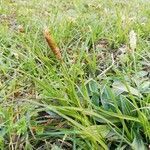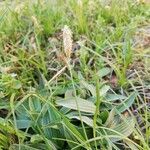Stems 2–6 dm, few together, from long rhizomes, phyllopodic, the main lvs 2–5 mm wide; terminal spike staminate, 1–2 cm; pistillate spikes 1–3, often staminate at the tip, rather loosely spreading, widely separated, the lower peduncles elongate, the upper shorter; bracts with rather loose sheaths 1–2 cm and short blades shorter than the spikes; pistillate scales shorter and narrower than the perigynia, purplish-brown, with or without a narrow green center, usually acute; perigynia usually in 2 rows, the lowerseparated by internodes 2–5 mm, the upper ± overlapping, glabrous, 2-keeled, otherwise rather obscurely nerved, 3.5–5 mm, fusiform-obovoid, with a somewhat outcurved beak ca 1 mm; achene obovoid-trigonous with concave sides, nearly filling the perigynium; 2n=32. Wet woods and bogs, chiefly in calcareous districts; circumboreal, s. in Amer. to Me., n. N.Y., n. Mich., n. Minn., Sask., and B.C. (C. saltuensis, the Amer. plants)
Plants colonial, long-rhizomatous. Culms 7–60 cm, ± smooth distally. Leaves: proximal sheaths bladeless, pale brown, slender, 0.7–2.8 mm diam., not or only very sparsely papillose; ligules 2–4.5 mm, longer than wide; blades of vegetative culms 5–40 cm × 1.5–4 mm; those of fertile culms green, flat, less than 10 cm. Inflorescences 6.5–25 cm, 2–5 times longer than proximal bracts; proximal bracts 2.5–8 cm, sheath 1–3.5 cm, blade 1–1.5 cm; pistillate spikes linear, 0.8–3 cm × 3–6.5 mm. Pistillate scales purple tinged, apex broadly acute or obtuse. Perigynia 3–15, the proximal loosely arranged, green to dark brown, often obscurely veined, 3.5–5 × 1.5–2.2 mm, smooth; beak slender, cylindric, (0.4–)0.6–1.8(–2.2) mm. Achenes light to dark brown, 2.2–3 × 1.2–1.5 mm. 2n = 32.



